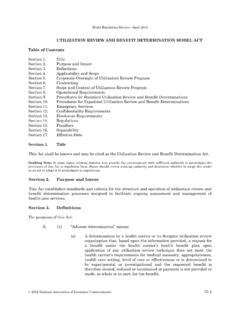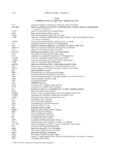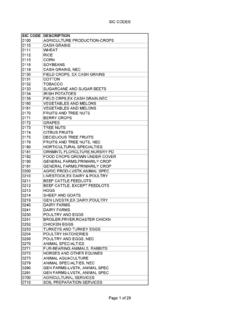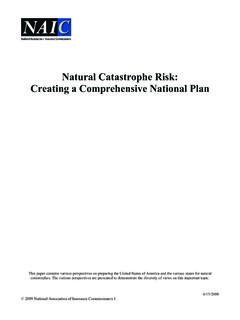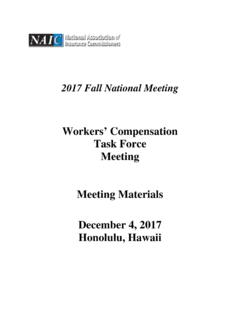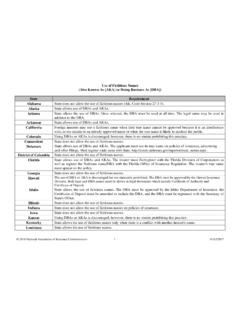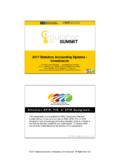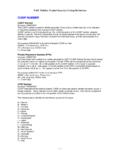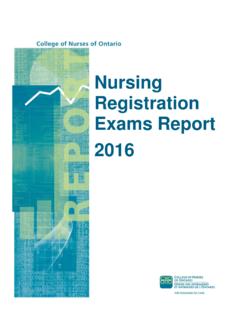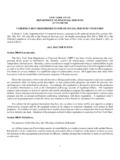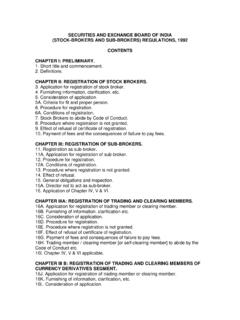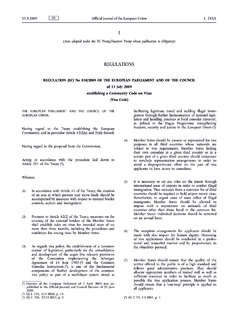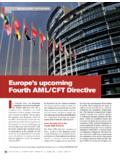Transcription of REGISTRATION AND REGULATION OF THIRD …
1 Model REGULATION Service October 2011 2011 National Association of Insurance Commissioners 1090-1 REGISTRATION AND REGULATION OF THIRD PARTY ADMINISTRATORS (TPAs) (An NAIC Guideline) This Guideline, offered in two versions, is a revision of the THIRD Party Administrator Statute, which was first adopted by the NAIC as a model law in 1977 and which had been most recently amended in 2001. Version 1 of the Guideline expands the scope of the prior model by adding workers compensation and stop-loss coverages. Version 2 of the Guideline omits workers compensation, which makes it similar in scope to the prior model, with the difference being in those states where stop-loss insurance was defined as liability insurance and not as health insurance. A state s best use of the Guideline will depend on whether it currently has a TPA law and/or whether it wants to have a TPA law that extends to the handling of workers compensation claims: For a state that wishes to enact a TPA law that extends to workers compensation, Version 1 should be an excellent starting point.
2 Study the language carefully to make whatever amendments may be necessary on account of state-specific issues with workers compensation, agent licensing and adjuster licensing statutes. The adjuster licensing statutes will probably require an especially careful examination to have a good mesh and to avoid duplicative requirements, while workers compensation statutes will need to be studied to determine whether the provisions of this document regarding the rights of employers to involve themselves in claims handling or disputes are in agreement. While part of a possible response to conflicts could be to change adjuster licensing or workers compensation laws to match this document, it is not the purpose of the Guideline to call for changes to other statutes.
3 Although drafting notes will provide assistance in this regard, one should not skim over sections without drafting notes. There are more state-to-state differences than can be easily summarized by drafting notes. A state that already has a TPA law, but that wants to extend it to workers compensation, will also find Version 1 to be an excellent reference. The advice for such a state is again to review this document carefully, looking to see where it differs from the state s current law and carefully noting where the changes proposed in this document may conflict with the state s other statutes. A state with or without a current TPA law, that wants to have a TPA law that does not extend to workers compensation, is advised to consider Version 2. Version 2 is essentially the same as Version 1, but with provisions and language related to workers compensation removed.
4 This law still includes stop-loss and other refinements made to the previous NAIC model. Admittedly, the motivation for a state to make changes to its existing laws is likely to depend on whether it has identified a reason that it needs to fix its current laws. Absent the identification of any practical problems, states may assign a lower priority to the improvements contained in this document. In addition to numerous editorial changes, some of the substantive changes to what was previously in the 2001 NAIC model law are as follow: (a) The language of the 2001 model required individuals adjusting life and health claims to be licensed as TPAs, even though it is clear that it was never the intent of the drafters or the states that adopted the model to implement a licensure requirement for employees of TPAs or insurers adjusting life and health claims.
5 In addition, the licensing provisions in the 2001 model allowed an individual to become licensed to act as a full-fledged TPA. While the Guideline has language to allow previously licensed individuals to be grandfathered, it provides that only business entities can be newly licensed as TPAs. As a practical matter, licensure requirements are not cleanly met by an individual. (b) The 2001 model exempted licensed insurers operating as TPAs from all requirements of the Act. The Guidelines maintain this exemption for lines other than workers compensation. For workers compensation, while Version 1 exempts insurers from licensure requirements and from audit and reporting requirements when they handle workers compensation claims for REGISTRATION and REGULATION of THIRD Party Administrators (TPAs) (An NAIC Guideline) 1090-2 2011 National Association of Insurance Commissioners an employer that is not their policyholder, it subjects such insurer/TPAs to many other operational requirements of the Act for workers compensation.
6 (c) The Guideline adds cease & desist orders to those actions available to the commissioner and also addresses concerns that the 2001 model may have been deficient with regard to due process. (d) The Guideline extends the life & health scope of the 2001 model to so-called stop-loss insurance. This may be viewed a clarification in states where stop-loss is already considered to be health insurance and cannot be written as liability insurance, but it will be a modest expansion in other states. (e) Version 1 extends the scope of the 2001 model to workers compensation insurance. One should note, however, that various provisions of the model applying to life & health are not uniformly extended to workers compensation. There is an extensive new section dealing with workers compensation contracts between insurers and TPAs, and between TPAs and insured employers.
7 (f) Version 1 will not allow a TPA to agree with an employer to have the employer adjust its own workers compensation claims, and an employer cannot avoid this prohibition by simply licensing an affiliated business entity as a TPA in order to handle its own workers compensation claims. (g) Version 1 exempts payments made by employers to TPAs for handling workers compensation claims under a large deductible contract from premium taxes. (h) The account-related provisions in the 2001 model were substantially revised. Most notably, the Guideline deletes the requirement that accounts administered by the TPA must be in the name of the insurance company, as long as claims trust funds held by the TPA are not commingled with premium trust funds.
8 Model REGULATION Service October 2011 2011 National Association of Insurance Commissioners 1090-3 THIRD PARTY ADMINISTRATOR ACT (NAIC Guideline Version 1) Drafting Note: This version 1 guideline includes workers compensation, while the version 2 guideline excludes workers compensation. A state that intends to adopt a TPA law should start with the version that is appropriate for its needs. Table of Contents Section 1. Definitions Section 2. Licensing Necessary Section 3. Workers Compensation; Agreement with an Affiliated TPA Section 4. Payment to a TPA Section 5. Maintenance of Information Section 6. Approval of Advertising Section 7. Responsibilities of the Payor and TPA Section 8. Premium Collection and Payment of Claims Section 9. Compensation to the TPA Section 10. Disclosure of Charges and Fees Section 11.
9 Workers Compensation; Agreements and Communication between Employers, TPAs and Insurers Section 12. Delivery of Materials to Covered Individuals Section 13. Home State TPA License Section 14. REGISTRATION Requirement Section 15. Nonresident TPA License Section 16. Annual Report and Filing Fee Section 17. Grounds for Suspension or Revocation of Licensure Section 18. Effective Date Section 1. Definitions For purposes of this Act: A. Affiliate or affiliated means a person who directly or indirectly through one or more intermediaries, controls or is controlled by, or is under common control with, another specified person. B. Business entity means a corporation, association, partnership, limited liability company or other legal entity. Drafting Note: Many laws use very broad definitions of entity that include individuals.
10 Provisions of this Act referring to business entities are specifically intended to exclude individuals, as the full scope of TPA responsibilities and requirements are not well-suited to licensure of an individual. In addition, an overbroad definition of entity or business entity could result in individuals working for TPAs being required to be individually licensed as TPAs. C. Collateral means funds, letters of credit or any item with economic value owned by the payor but held by an insurer or TPA in case it needs to be used to fulfill premium or loss reimbursement obligations in accordance with a contract between the insurer or TPA and the payor. Collateral shall include anticipated loss prepayments made prior to the payment of losses, pursuant to arrangements where reimbursement is not due until after losses have been paid.
